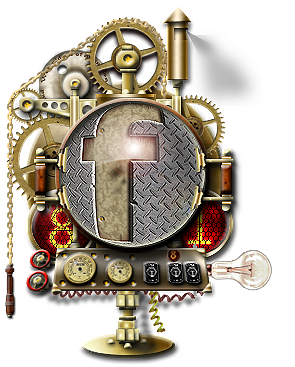While there is nothing Steampunk about HeroQuest, we are still fans of this classic board game and the Chicago Steampunk Exposition would like to share some hacks and home brew rules of ours.
Magnetic Tiles
As pictured above, we play HeroQuest on a magnetic dry erase board, using magnetic tiles to create the dungeon. The classic board is much loved, but this modular system adds the “fog of war” element to make the dungeon more mysterious.
For this set up you will need:
- 36 inch by 24 inch dry erase board (about $32)
- Laminating Machine (about $34)
- Thermal Laminating Pouches (about $18)
- Magnetic Sheets (about $18)
- Color Printing (see PDF link below)
The total cost is about $102 plus printing costs, but you will have plenty of laminating pouches and magnetic sheets left over to make even more terrain tiles for other games (we have an extensive range of D&D tiles in this fashion), plus you have a dry erase board!
We recommend laminating the whole sheet before cutting out the tiles (it’s easier all round), and cutting the magnetic sheets into 1 inch squares, placing one per corner of the tile. With corridor pieces a 1 inch by 1.75 inch strip at each end of the tile works well.
Printing Tip: make sure to choose “Actual Size” when printing; most software defaults to “Fit to Page” which reduces the square size to under an actual inch.
Click on the map to access the PDF of the full-size tiles.
Additionally some furniture pieces can be magnetized with strips from the sheets, but when placed on the tiles they are not as strong as direct contact with the board, so you might want to consider a stronger magnet alternative for this.
Dry Erase Character Sheets & Dice
We also present to you letter sized character sheets, which if laminated can be used reused with wet or dry erase pens. Click on the image below for the characters we have thus far: Barbarian (male), Dwarf (male), Elf (female), Wizard (male), Rogue (male), Rogue (female), and Knight (male).
Due to limited dice (and trust issues with players younger than the 14+ recommendation on the box), we use regular dice to play the game. Statistically the specialized HeroQuest dice are: Skull 3/6 chance, Lion Shield 2/6, and Zargon Shield 1/6. We translated this to 1 to 3 is a fail, 4+ is a hit, 5+ is a hero’s defense target, and 6 is needed by monsters to defend. We’ve added a bit of flair to it by adding descriptors to each die roll level: all pieces need a success to hit, heroes need a hard success to defend, and monsters need an extreme success to defend.*
Click on the Character Sheet to access the PDF of the full-size character sheets.
What’s the tracker along the bottom? Looks rather like Zombicide . . . We are further developing our home brew to make a sort of hybrid version that thus far has sped up game play considerably; see below for more.
* Call of Cthulhu RPG fans will recognize this terminology 🙂
Home Brew, or Radical Changes?
Over the decades, many games of HeroQuest have thrown out the two red dice to move rule and replaced it with their own home brew. For our game, we use zones for movement, taken from Zombicide – Black Plague; we’ve also taken on the action economy of each hero starting with three actions per round. Movement to an adjacent zone costs one action, so a player can move a maximum of three zones (note, however, a hero’s ability to move comes to an end when confronted by a new monster). Each room is considered a zone, and corridor tiles are mostly dived into 6 square long sections to form a zone (when a hero enters a corridor zone tile, the next one is revealed ahead of them). With the zone rule, any piece in the same room can attack another piece in that same room (or corridor zone), so the actual squares are not important in this home brew version (and it speeds up combat a lot!).
In our home brew ALL actions require a player to use one of their three action points. So, searching a room, that’s an action point! Attacking a monster, that’s an action point! Opening a door, that’s an action point! . . . and so on. This does allow a hero to attack multiple times so we have increased the body points on some monsters and allowed monsters multiple action points as well (home brew monster cards coming soon!). The standard action point economy is 3 points, with slower monsters getting just 2, and faster ones getting 4 actions. Dread Warriors and Abominations are tough but slow (2 actions), Orcs are much like our heroes (3 actions), and Goblins are weak, but fast (4 actions); the Elf also gets 4 actions. As mentioned earlier, new custom cards and a chart are in the works.
The tracker along the bottom of the character sheet (shown above) is for a Zombicide like experience point tracker that will be used to unlock skills (see the Rogue and Knight sheets), but that is also a “under construction” aspect of our home brew. Perhaps you can figure it out and tell us 🙂
Hmmmm? While there is nothing Steampunk about HeroQuest, how much fun would it be to develop a Steampunk version of the game 😀








